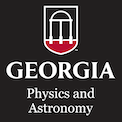For this talk, I will recount some of my experiences as an undergraduate physics and astronomy student at the University of Georgia, including challenges I faced and (sometimes) overcame, and lessons learned from such experiences. I will also describe how my experiences as an undergraduate helped prepare for and shape some of my future career decisions. I will then describe some of my research accomplishments after my time as an undergraduate, and how I entered into the research world of brown dwarfs and exoplanets. I will then discuss in detail one of my current projects that I'm most passionate about -- the citizen science project BackyardWorlds.org -- which engages layperson volunteers to examine infrared images to look for nearby substellar objects in the vicinity of the Sun, and has the potential to discover new planets within our own solar system.
Events Calendar View
-
Departmental Colloquium
Apr 25, 2019
From UGA to Beyond: Brown Dwarfs, Exoplanets, and Overhead Projectors

Guest: Dr. Adam Schneider, Arizona State University
Thursday, April 25, 2019 3:30 pm - 4:30 pm
Location: Physics Auditorium (202) -
Applied Physics Seminar
Apr 26, 2019
The molecular mechanism of influenza virus inactivation by hypothiocyanite
Respiratory viral infections are the most common illnesses worldwide affecting people today. One of them is influenza virus (IV) that causes ongoing epidemics with high morbidity and variable mortality. The ability of IV to rapidly change allowed it to stay ahead of vaccination efforts. Novel therapeutic approaches are needed to fight influenza. We have previously described an extracellular oxidative antimicrobial mechanism utilized by the respiratory innate immune system to inactivate IV. The lactoperoxidase/thiocyanate system produces reactive oxygen species, mainly hypothiocyanite anions, that have strong antiviral properties against IV in vitro. Our main focus is to reveal the molecular mechanism by which hypothiocyanite inactivates influenza viruses and whether it also prevents in vivo infections. Our data shows that hypothiocyanite is able to inactivate several IV strains including A and B strains and those resistant to current antiviral ostetamivir therapies. This data was also backed up by neuraminidase activity assays showing no reduction in viral NA activity when exposed to hypothiocyanite. Additionally, pre/co-incubation of IV with hypothiocyanite prevents infection of a variety of host epithelial cells by the virus. The ability of IV to bind to target cells is also strongly reduced when exposed to hypothiocyanite. These results suggest that hypothiocyanite primarily targets the surface hemagglutinin molecules of IV to prevent viral binding to and infection of target cells. This hypothesis represents a novel mechanism of viral inactivation utilized by the immune system.
-
CSP Lunch Seminar
Jul 9, 2019
Sensing Chaos through Dynamic Diffraction
Oversampling an object using Fraunhofer diffraction ensures a continuous diffraction pattern. This oversampling technique ensures that the background intensity in the frame surrounding the object remains uniform. An application to dynamic diffraction patterns is the study of the locomotory behavior of microscopic biological species. Almost all studies of microscopic species are conducted on microscope slides so that the species are constrained to two dimensions. Using diffraction with a collimated low intensity laser beam frees the species from the image plain. We choose C. elegans as a microscopic species to demonstrate the chaotic locomotion of the worms.
In addition, dynamic diffraction allows for the optical production of a single time series in complex space that contains information about the time evolution of every single point in real space. This complex time series contains information on locomotory cycles, embedding dimensions and the largest Lyapunov exponent (LLE). Here we distinguish two different phenotypes ofC. elegans, a nematode, by calculating LLE's. The importance of switching behavior will be discussed.
-
Departmental Colloquium
Aug 15, 2019
Photon Upconversion Sensitized by Bulk Lead-Halide Perovskite Films
The sub-bandgap onset of rubrene-based organic light emitting diodes serves as an indicator of direct triplet exciton sensitization based on charge injection. Hence, materials which have a proper band alignment to allow for direct charge injection into the triplet state can enable a new path in sensitizing excitonic photon upconversion, while overcoming previous limitations resulting from poor exciton diffusion in nanocrystal-based systems. In particular, bulk lead halide perovskite (LHPs) thin films have emerged as efficient sensitizers for near-infrared-to-visible upconversion. The upconversion process is based on triplet-triplet annihilation (TTA) in the annihilator rubrene. Conservative estimates result in upconversion efficiencies upwards of 3%,[1] and upconversion has been shown to be efficient at incident powers comparable to the solar flux.
Understanding the upconversion mechanism is crucial for the advancement of such devices. Our observations indicate that non-radiative trap filling in the LHP film and charge transfer to rubrene are likely competing pathways for the optically excited charge carriers. As a result, we obtain lower intensity thresholds Ith for efficient upconversion using thicker perovskite films, as these exhibit lower trap densities. However, a trade-off is observed: with increasing film thickness parasitic reabsorption of the singlets created by TTA also increases, which diminishes the visible light output of the device. [2]
Two unexpected effects have been observed in perovskite-based upconversion devices: i) two rise times in the upconverted photoluminescence dynamics, and ii) a reversible ‘photobleach’ of the resulting upconverted emission. Both effects can be traced back to the existing triplet population level and the resulting population-dependent diffusion length, indicating that further optimization of the device is still needed. [3]
[1] Nienhaus et al. ACS Energy Lett. 2019, 4, 888-895
[2] Wieghold et al. Matter 2019, https://doi.org/10.1016/j.matt.2019.05.026
[3] Wieghold et al. J. Phys. Chem. Lett. 2019, https://doi.org/10.1021/acs.jpclett.9b01526 -
CSP Lunch Seminar
Aug 20, 2019
Introduction to GACRC Computing Facility - Sapelo2 Cluster
-
Departmental Colloquium
Aug 22, 2019
Spin Dynamics Under the Effect of Superparamagnetic Nanoparticles and Rashba Spin-Orbit Coupling
Spintronics refers to the study of the role that electron spin plays in solid state physics and the possible devices that specifically exploit spin properties instead of, or in addition to, charge degrees of freedom. For practical applications, novel materials with long spin lifetimes and allowable spin coherent manipulation are paramount. In this colloquium, I will present (i) a novel way of manipulating electron spins in organic semiconductors (OSECs) by magnetic nanoparticles (MNPs)[1], and (ii) the role of Rashba spin-orbit coupling (SOC) in the optoelectronic and spin response in 2D and 3D organic/inorganic hybrid lead halide perovskite materials [2]. For the former, we demonstrated that Fe3O4 MNPs with superparamagnetic properties generate large magnetic dipole–dipole interaction with electron spins in OSECs. This interaction was found to be analogous to the effects of hyperfine interaction. Our study yields a new pathway for tuning OSECs’ magnetic functionality, which is essential for organic optoelectronic devices and magnetic sensor applications. For the latter, the presence of heavy Pb atoms in the perovskite crystal leads to a large intrinsic SOC, which, when combined with the breaking of the inversion symmetry, gives rise to giant Rashba-type SOC. In this part, I will show our preliminary results of Rashba SOC strength from 2D and 3D perovskites that depends on their structural inversion symmetry breaking, using several spintronic tools including magnetic field effects on conductivity, magnetic circular dichroism, and circular photoluminescence spectroscopy. Materials with strong Rashba SOC are particularly useful for electric-field controlled spin dynamics for future spin transistor logic devices.
[1] Geng et al. DOI: 10.1039/c9mh00265k (2019)
[2] Stranks et at. Nature Materials17, 381–382 (2018)
Page 94 of 121, showing 6 records out of 723 total, starting on record 559, ending on 564





